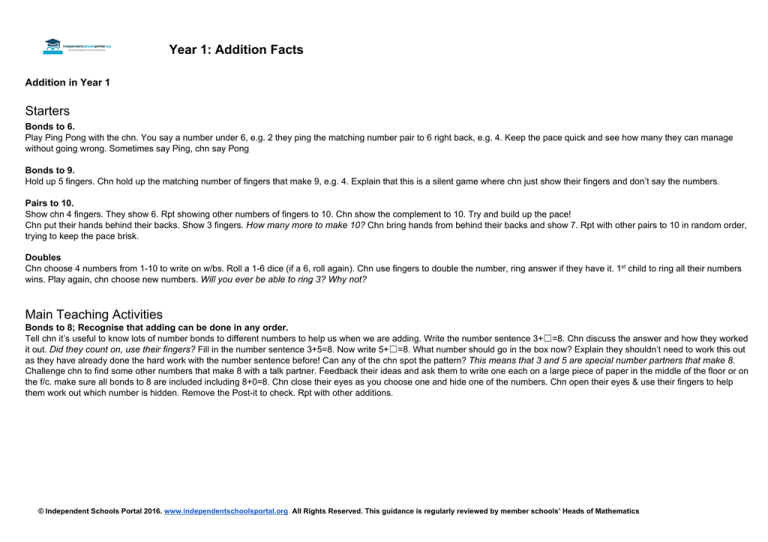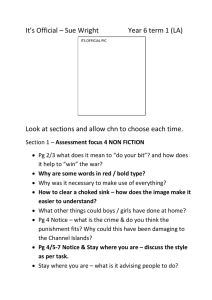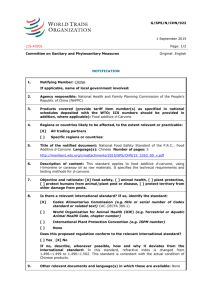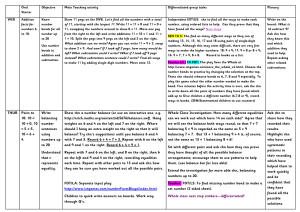
Addition in Year 1 Year 1: Addition Facts
Starters Bonds to 6. Play Ping Pong with the chn. You say a number under 6, e.g. 2 they ping the matching number pair to 6 right back, e.g. 4. Keep the pace quick and see how many they can manage without going wrong. Sometimes say Ping, chn say Pong Bonds to 9. Hold up 5 fingers. Chn hold up the matching number of fingers that make 9, e.g. 4. Explain that this is a silent game where chn just show their fingers and don’t say the numbers. Pairs to 10. Show chn 4 fingers. They show 6. Rpt showing other numbers of fingers to 10. Chn show the complement to 10. Try and build up the pace! Chn put their hands behind their backs. Show 3 fingers
. How many more to make 10?
Chn bring hands from behind their backs and show 7. Rpt with other pairs to 10 in random order, trying to keep the pace brisk. Doubles Chn choose 4 numbers from 1­10 to write on w/bs. Roll a 1­6 dice (if a 6, roll again). Chn use fingers to double the number, ring answer if they have it. 1st
child to ring all their numbers wins. Play again, chn choose new numbers.
Will you ever be able to ring 3? Why not? Main Teaching Activities Bonds to 8; Recognise that adding can be done in any order. Tell chn it’s useful to know lots of number bonds to different numbers to help us when we are adding. Write the number sentence 3+☐=8. Chn discuss the answer and how they worked it out.
Did they count on, use their fingers? F
ill in the number sentence 3+5=8. Now write 5+☐=8. What number should go in the box now? Explain they shouldn’t need to work this out as they have already done the hard work with the number sentence before! Can any of the chn spot the pattern?
This means that 3 and 5 are special number partners that make 8. Challenge chn to find some other numbers that make 8 with a talk partner. Feedback their ideas and ask them to write one each on a large piece of paper in the middle of the floor or on the f/c. make sure all bonds to 8 are included including 8+0=8. Chn close their eyes as you choose one and hide one of the numbers. Chn open their eyes & use their fingers to help them work out which number is hidden. Remove the Post­it to check. Rpt with other additions. © Independent Schools Portal 2016.
www.independentschoolsportal.org
All Rights Reserved. This guidance is regularly reviewed by member schools’ Heads of Mathematics Year 1: Addition Facts
Bonds to 9; Recognise that adding can be done in any order. Write the addition sentences: 9+0, 3+6, 7+2, 4+5, 8+1 on the board.
What do they all have in common?
They are all number bonds to 9!
Using those same numbers can we find any more number bonds to 9? How do we do that?
Point that they can just swap the numbers around as addition can be done in any order! Write all the number bonds down on the f/c. We can use these to help us work out subtraction number bonds.
Write 9­4= Can they use any of the addition number bonds to work this out?
4+5 are special partners so let’s see if 9­4=5 works.
Demonstrate by using cubes. Now write 9­2=
What is the matching number partner to 2?
Chn discuss and complete the number sentence, e.g. 9­2=7. In pairs chn see if they can find more subtraction number bonds to 9. Find doubles to double 6 What is double 3?
Ask chn to explain how they worked it out. Explain that when we double a number we are actually adding it onto itself, e.g. 4+4, 6+6 etc. Ask chn to work in pairs to show double 1, 2, 3, 4, 5 and 6, by each child showing 1, 2, 3, 4, 5, then 6 fingers. When you say double 1 is… for example, they shout the answer. Draw a 3 by 2 grid on the IWB. Fill with numbers 1 to 6. Choose a child to pick one of the numbers and ask the rest of the class to write the number sentence for that double, e.g. child chooses 3, chn write 3+3=6. Rpt with other numbers from the grid. Add three numbers using number bonds to 10. rd
Show 3 spotty dice; the first two each showing 5 spots and the 3 showing 3 spots.
What’s the total number of spots on the first two dice? Do you need to count them all? No, we can see 5 on each, and we know 5 and 5 makes 10. Now we need to add on 3. What's 10 add 3? Do we need to count on ones?
If necessary show 10 and 3 more on the bead bar to help chn recognise that the answer is 13. Discourage counting on in ones! Move the spotty dice around and show 5, 2 and 5 spots in that order.
What’s the total now? We could add 2 onto 5, that’s 7. Now we need to count on the other 5.
Put up 5 fingers to add on 5, and count on
8, 9, 10, 11, 12. But there is an easier way – watch!
Move the two 5 dice together. What have we got now? Here is 10, and then other 2 makes 12! We get the same answer when we move them around, but this is an easier order to add them by, by spotting the pair to 10.
Show 6, 5 and 4 spots.
Let’s find the total.
Can you see a pair to 10?
Move the 6 and 4 together.
And now we can add the 5!
Show chn 3 digit cards; 5, 2 and 8.
What might be the best way to add these? Can you see a pair to 10? Write the best order on your w/bs.
Take feedback, and move the 8 and 2 together to make 10, and then add 5. Rpt with other trios, always ensuring that there is a pair to 10. Adding three numbers using doubles and number bonds. Shuffle 2 packs of 0­9 digit cards, and take these 3 cards: 4, 3 and 4.
What's the best way to add these together? There’s no pair to 10 this time. Oh, but look there are two 4s. What’s double 4?
Move the two 4s together, and place the 3 after them.
So now we need to work out 8 add 3.
Mark on 8 on the 0­20 beaded line, and draw a hop of 3, labelling it + 3. Where have we landed?
Mark on 11.
So what is the total? R
ecord 4 + 4 + 3 = 11.
This is the order we used. We can also add on 3 by counting on our fingers. Hold up 3 fingers. We’d got 8 so now we add on three, 9, 10, 11. P
ut the cards back and take out another 3, e.g. 2, 3 and 9.
How shall we add these? There’s no pair to ten or double this time. We
could add them in order, but 9 is quite a bit to count on, so lets put the biggest number 1st
.
Rearrange the cards to show 9, 3 and 2. Use the beaded line/fingers to find the answer. © Independent Schools Portal 2016.
www.independentschoolsportal.org
All Rights Reserved. This guidance is regularly reviewed by member schools’ Heads of Mathematics Year 1: Addition Facts
Guided / Independent Work Adding on to 8 Harder As Most chn but once chn have created their addition number bonds they can work in pairs to see if they can find all of the subtraction number bonds to 8, e.g. 8­6=2, 8­4=4 etc. Most children Provide chn with dice and they work in pairs to take it turns to roll a die. They both write this number down, e.g. 6 and work out how much more is needed to make 8 using their fingers to help where necessary. They write the corresponding number sentence, e.g. 6+2=8. GUIDED: Easier (8 chn) Hand out number cards from 0­7 to each child. Organise chn into a circle and place the additions from the whole class teaching in the middle. Explain that you are going to call a name and that child is going to start by saying the matching number partner to 8 that they have on their card. Then follow the circle round with each child saying their matching number as quickly as possible until everyone has had a go. They then swap their card with the child next to them and rpt but this time with number bonds sheets upside down. After a few turns chn then find a matching partner with the matching number bond to 8. They then both write that number sentence down on their w/bs, e.g. 3+5=8. Adding on to 9 Harder As most chn but also challenge children to create subtraction number sentences so if they pick a 2 they would write 9­2=7 etc. Most children Children work in pairs to turn over number cards 0 to 9. They create a number sentence using the matching number bonds to 9. If their partner agrees with the number sentence they give their partner a counter. Rpt. with the other child picking a number and creating a number sentence. GUIDED: Medium Put 9 cubes in a feely bag. Choose a child to come and take out some. They count them and place them in the middle of the table, e.g. 5.
There were 9 cubes in my bag, how many cubes will be left now?
Chn write the answer on their w/b, using their fingers to help if necessary. Take answers and then count out the remaining cubes and place them in a pile next to the first pile.
How can we make a number sentence out of this?
5+4=9 and 9­5=4. Rpt, putting all the cubes back in and then choosing a new child to take some out. Easier Chn complete the cake candle number bonds sheet (
see resources
). They count the candles on one side of the cake and then draw on the matching number to make 9 candles on the cake altogether. © Independent Schools Portal 2016.
www.independentschoolsportal.org
All Rights Reserved. This guidance is regularly reviewed by member schools’ Heads of Mathematics Year 1: Addition Facts
Bear doubles to 8 (10 for higher ability) Most children Ask children to complete the bear doubles sheet (
see resources
). Chn write the doubles number sentence underneath the bear. GUIDED: Harder Cut out the bear templates and place in a box. Chn close their eyes and fish out the bears! They create a doubles number sentence from the number on the bear. If they get it correct they get to keep their bear. Keep going with different doubles. Add up the number of bears they have collected at the end. Easier As most chn but chn use cubes to work out the answer to the double additions. 3 numbers, spotting a pair to 10 Most children Chn practise adding 3 numbers spotting a pair to 10 (
see resources
). GUIDED: Medium In advance make 9 skittles out of plastic bottles filled with sand (small pop or juice bottles work well). Label them with some bonds to 10, e.g. 1­9. Chn take it in turns to roll a ball to knock down the skittles. The aim is to knock down 3 skittles. If they have only knocked down 1 or 2, they have another go. The 3 highest numbers count. They look for a pair with a total of 10 and add on the highest numbered other skittle to find their total score. Rpt several times. Easier Activity sheet has 0­20 beaded lines on to support. Harder th
Chn roll a 1­6 dice to add on a 4 number. © Independent Schools Portal 2016.
www.independentschoolsportal.org
All Rights Reserved. This guidance is regularly reviewed by member schools’ Heads of Mathematics Plenaries Year 1: Addition Facts
●
●
●
●
●
Choose nine chn to write a number bond to 8 on a piece of card folded in half. Ask chn to come to the front and order themselves from 8+0=8, 7+1=8… Hang on a washing line. Can chn see a pattern? Which number bonds are the same, but just switched round? (2 + 6 = 8 and 6 + 2 = 8.) Choose two chn from the guided group to play the feely bag game with the rest of the class. Organise chn into circle or take the class outside. Throw a beanbag to a child and call out a number under 12 at the same time. Chn catch the beanbag and say the double with that answer, e.g.
you say 6, they say double 3.
Rpt with other even numbers to 10, throwing the beanbag to other chn. Show 3 digit cards. Chn show thumbs up if there is a pair to 10, thumbs down if not. Repeat. Roll 3 spotty dice. Chn discuss in pairs how they would find the total. Take feedback, and move the dice accordingly. Rpt. Suggested Resources ●
●
●
●
●
●
●
●
●
●
●
●
●
Dice Number cards 0­10 Pieces of card Cubes Feely bag Cake candle number bonds sheet (see resources) Bear doubles sheet (see resources) Doubles bears (see resources) Beanbag Adding 3 numbers sheet (see resources) Empty plastic bottles (9 to make skittles from) Spotty dice 0 to 9 digit cards © Independent Schools Portal 2016.
www.independentschoolsportal.org
All Rights Reserved. This guidance is regularly reviewed by member schools’ Heads of Mathematics







